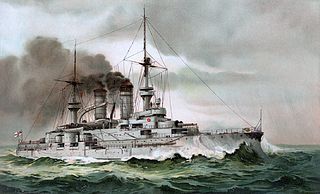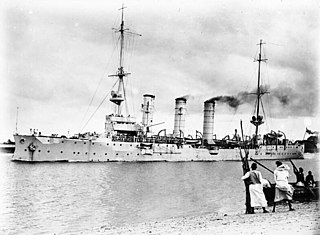
SMS Scharnhorst was an armored cruiser of the Imperial German Navy, built at the Blohm & Voss shipyard in Hamburg, Germany. She was the lead ship of her class, which included SMS Gneisenau. Scharnhorst and her sister were enlarged versions of the preceding Roon class; they were equipped with a greater number of main guns and were capable of a higher top speed. The ship was named after the Prussian military reformer General Gerhard von Scharnhorst and commissioned into service on 24 October 1907.

SMS Gneisenau was an armored cruiser of the German Kaiserliche Marine, part of the two-ship Scharnhorst class. Named for the earlier screw corvette of the same name, the ship was laid down in June 1904 at the AG Weser shipyard in Bremen, launched in June 1906, and commissioned in March 1908. She was armed with a main battery of eight 21 cm (8.3 in) guns, a significant increase in firepower over earlier German armored cruisers, and she had a top speed of 22.5 knots. Gneisenau initially served with the German fleet in I Scouting Group, though her service there was limited owing to the British development of the battlecruiser by 1909, which the less powerful armored cruisers could not effectively combat.

SMS Leipzig was the sixth of seven Bremen-class cruisers of the Imperial German Navy, named after the city of Leipzig. She was begun by AG Weser in Bremen in 1904, launched in March 1905 and commissioned in April 1906. Armed with a main battery of ten 10.5 cm (4.1 in) guns and two 45 cm (18 in) torpedo tubes, Leipzig was capable of a top speed of 22.5 knots.

SMS Dresden was a German light cruiser built for the Kaiserliche Marine. The lead ship of her class, she was laid down at the Blohm & Voss shipyard in Hamburg in 1906, launched in October 1907, and completed in November 1908. Her entrance into service was delayed by accidents during sea trials, including a collision with another vessel which necessitated major repairs. Like the preceding Königsberg-class cruisers upon which her design was based, Dresden was armed with ten 10.5 cm (4.1 in) SK L/40 guns and two torpedo tubes.

The Bayern class was a class of four super-dreadnought battleships built by the German Kaiserliche Marine. The class comprised Bayern, Baden, Sachsen, and Württemberg. Construction started on the ships shortly before World War I; Baden was laid down in 1913, Bayern and Sachsen followed in 1914, and Württemberg, the final ship, was laid down in 1915. Only Baden and Bayern were completed, due to shipbuilding priorities changing as the war dragged on. It was determined that U-boats were more valuable to the war effort, and so work on new battleships was slowed and ultimately stopped altogether. As a result, Bayern and Baden were the last German battleships completed by the Kaiserliche Marine.

The Mackensen class was the last class of battlecruisers to be built by Germany in World War I. The design initially called for seven ships, but three of them were redesigned as the Ersatz Yorck class. Of the four ships of the Mackensen class, Mackensen, Graf Spee, and Prinz Eitel Friedrich were launched, and Fürst Bismarck was not—but none were completed, after wartime shipbuilding priorities were redirected towards U-boats—and the ships were broken up in the early 1920s. The lead ship of the class was named for August von Mackensen, a prominent military commander during the war. In response to the Mackensen-class ships, the British Royal Navy laid down the Admiral-class battlecruisers, all but one of which would eventually be cancelled; the sole survivor, HMS Hood, was completed after the end of the war.

HMS Monmouth was the name ship of her class of 10 armoured cruisers built for the Royal Navy in the first decade of the 20th century. The ships were also known as the County Cruisers.

The Scharnhorst class was a class of German battleships built immediately prior to World War II. The first capital ships of Nazi Germany's Kriegsmarine, it comprised two vessels: Scharnhorst and Gneisenau. Scharnhorst was launched first, and is considered to be the lead ship by some sources; they are also referred to as the Gneisenau class in some other sources, as Gneisenau was the first to be laid down and commissioned. They marked the beginning of German naval rearmament after the Treaty of Versailles. The ships were armed with nine 28 cm (11 in) SK C/34 guns in three triple turrets; plans to replace these with six 38 cm (15 in) SK C/34 guns in twin turrets were never realized.

The Deutschland class was a series of three Panzerschiffe, a form of heavily armed cruiser, built by the Reichsmarine officially in accordance with restrictions imposed by the Treaty of Versailles. The ships of the class, Deutschland, Admiral Scheer, and Admiral Graf Spee, were all stated to displace 10,000 long tons (10,160 t) in accordance with the Treaty, though they actually displaced 10,600 to 12,340 long tons at standard displacement. The design for the ships incorporated several radical innovations, including the first major use of welding in a warship and all-diesel propulsion. Due to their heavy armament of six 28 cm (11 in) guns and lighter weight, the British began referring to the vessels as "pocket battleships". The Deutschland-class ships were initially classified as Panzerschiffe, but the Kriegsmarine reclassified them as heavy cruisers in February 1940.

The Wittelsbach-class battleships were a group of five pre-dreadnought battleships built for the German Kaiserliche Marine in the early 1900s. They were the first battleships ordered under the Second Navy Law of 1898, part of Admiral Alfred von Tirpitz's fleet expansion program. The class comprised the lead ship, Wittelsbach, and Wettin, Zähringen, Schwaben, and Mecklenburg. All five ships were laid down between 1899 and 1900 and were finished by 1904. The ships of the Wittelsbach class were similar in appearance to their predecessors in the Kaiser Friedrich III class, but had a more extensive armor belt and a flush main deck, as opposed to the lower quarterdeck of the previous class. Both classes carried a battery of four 24 cm (9.4 in) guns in two twin-gun turrets.

The Derfflinger class was a class of three battlecruisers of the Imperial German Navy. The ships were ordered for the 1912–13 Naval Building Program of the German Imperial Navy as a reply to the Royal Navy's two new Lion-class battlecruisers that had been launched a few years earlier. The preceding Moltke class and the incrementally improved Seydlitz represented the end of the evolution of Germany's first generation of battlecruisers. The Derfflinger class had considerable improvements, including a larger primary armament, all of which was mounted on the centerline. The ships were also larger than the preceding classes. The Derfflinger class used a similar propulsion system, and as a result of the increased displacement were slightly slower.

The Roon class was a pair of armored cruisers built for the German Kaiserliche Marine in the 1900s. The two ships of the class, Roon and Yorck, closely resembled the earlier Prinz Adalbert-class cruisers upon which they were based. The Roon class incorporated slight incremental improvements, including a pair of extra boilers. The ships were easily distinguished from their predecessors by the addition of a fourth funnel. Though the additional boilers were meant to increase the ships' speed, both vessels failed to reach their designed top speed. In addition, the ships had comparatively light armament and thin armor protection, so they compared poorly with their foreign contemporaries, particularly the armored cruisers of their primary opponent, the British Royal Navy.

SMS Yorck was the second and final ship of the Roon class of armored cruisers built for the German Kaiserliche Marine as part of a major naval expansion program aimed at strengthening the fleet. Yorck was named for Ludwig Yorck von Wartenburg, a Prussian field marshal. She was laid down in 1903 at the Blohm & Voss shipyard in Hamburg, launched in May 1904, and commissioned in November 1905. The ship was armed with a main battery of four 21 cm (8.3 in) guns and had a top speed of 20.4 knots. Like many of the late armored cruisers, Yorck was quickly rendered obsolescent by the advent of the battlecruiser; as a result, her peacetime career was limited.

The Prinz Adalbert class was a group of two armored cruisers built for the German Kaiserliche Marine under the terms of the Second Naval Law. Two ships of the class were built, Prinz Adalbert and Friedrich Carl, between 1900 and 1904. The two ships were heavily based on the previous armored cruiser, Prinz Heinrich, with a series of incremental improvements. Their armor layout was revised slightly to improve internal protection and their main battery consisted of four 21 cm (8.3 in) guns instead of the two 24 cm (9.4 in) carried by Prinz Heinrich. The new ships also received more powerful propulsion systems, making them slightly faster. Prinz Adalbert spent her peacetime career as a gunnery training ship while Friedrich Carl initially served as the flagship of the fleet's reconnaissance forces. By 1909, she had been replaced by more modern cruisers and joined Prinz Adalbert as a training vessel.

SMS Prinz Heinrich was a unique German armored cruiser built at the turn of the 20th century for the German Kaiserliche Marine, named after Kaiser Wilhelm II's younger brother Prince Heinrich. The second vessel of that type built in Germany, Prinz Heinrich was constructed at the Kaiserliche Werft in Kiel, being laid down in December 1898, launched in March 1900, and commissioned in March 1902. Prinz Heinrich's design was a modification of the previous armored cruiser, Fürst Bismarck, and traded a smaller main battery and thinner armor for higher speed. All subsequent German armored cruisers were incremental developments of Prinz Heinrich.

The Dresden class was a pair of light cruisers built for the Imperial German Navy in the early part of the 20th century. The class comprised SMS Dresden, the lead ship, and SMS Emden. Both ships were laid down in 1906; Dresden was launched in 1907, and Emden followed in 1908. They entered service in 1908 and 1909, respectively. The design for the ships was an incremental improvement over the preceding Königsberg class, being slightly larger and slightly faster, but with the same primary armament of ten 10.5 cm (4.1 in) guns. Dresden and Emden were powered by steam turbines and triple expansion engines, respectively, as part of continued experiments with the new turbine technology.

The Königsberg class was a group of four light cruisers built for the German Imperial Navy. The class comprised four vessels: SMS Königsberg, the lead ship, SMS Nürnberg, SMS Stuttgart, and SMS Stettin. The ships were an improvement on the preceding Bremen class, being slightly larger and faster, and mounting the same armament of ten 10.5 cm SK L/40 guns and two 45 cm (17.7 in) torpedo tubes.
The Ersatz Yorck class was a group of three battlecruisers ordered but not completed for the German Kaiserliche Marine in 1916. The three ships had originally been ordered as additions to the Mackensen class, but developments abroad, particularly the British Renown-class battlecruisers, led to the navy re-designing the ships. The primary change was an increase of the main battery from eight 35-centimeter (14 in) guns to eight 38 cm (15 in) weapons. Work on the first ship had already begun by the time the navy decided to re-design the ships, so the design staff was constrained by the need to use the material already assembled.

SMS Nürnberg, named after the Bavarian city of Nuremberg, was a Königsberg-class light cruiser built for the German Imperial Navy. Her sisters included Königsberg, Stettin, and Stuttgart. She was built by the Imperial Dockyard in Kiel, laid down in early 1906 and launched in August of that year. She was completed in April 1908. Nürnberg was armed with ten 4.1-inch (100 mm) guns, eight 5.2 cm (2.0 in) SK L/55 guns, and two submerged torpedo tubes. Her top speed was 23.4 knots.






















